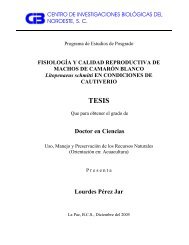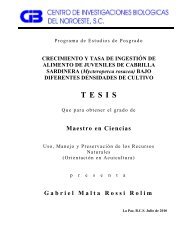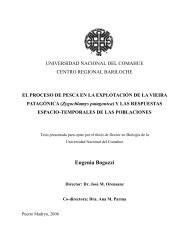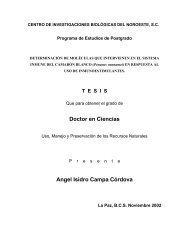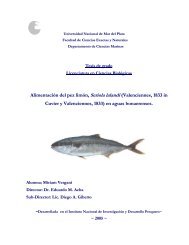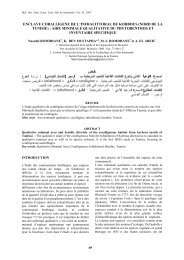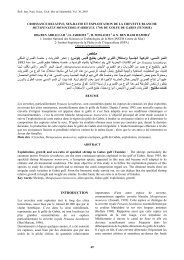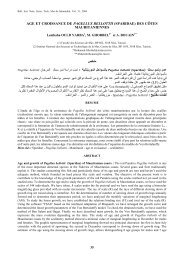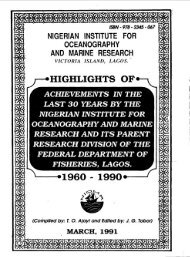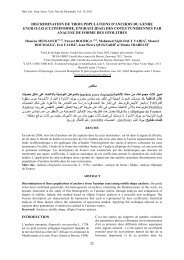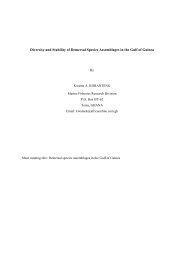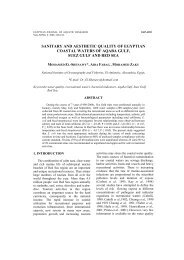Coastal vulnerability, resilience and adaptation to ... - OceanDocs
Coastal vulnerability, resilience and adaptation to ... - OceanDocs
Coastal vulnerability, resilience and adaptation to ... - OceanDocs
Create successful ePaper yourself
Turn your PDF publications into a flip-book with our unique Google optimized e-Paper software.
the traditional interpretation of <strong>resilience</strong>, which is based on the premise of <strong>resilience</strong> being<br />
tested by an initial perturbation. The distinction made by Dovers <strong>and</strong> H<strong>and</strong>mer (1992) is<br />
based on the major difference between ecosystems <strong>and</strong> societies: the human capacity for anticipation<br />
<strong>and</strong> learning.<br />
Dovers <strong>and</strong> H<strong>and</strong>mer (1992) thus link <strong>resilience</strong> <strong>to</strong> planning <strong>and</strong> <strong>adaptation</strong> <strong>to</strong> hazards. In<br />
a later paper, they develop a typology of institutional <strong>resilience</strong>, which provides a framework<br />
for considering the rigidity <strong>and</strong> inadequacy of present institutional responses <strong>to</strong> global environmental<br />
change (H<strong>and</strong>mer <strong>and</strong> Dovers, 1996). They argue that current institutions <strong>and</strong> policy<br />
processes appear <strong>to</strong> be locked in a type of <strong>resilience</strong> that is characterised by change at<br />
the margins. Responses <strong>to</strong> environmental change are shaped by what is perceived <strong>to</strong> be politically<br />
<strong>and</strong> economically palatable in the near term rather than by the nature <strong>and</strong> scale of the<br />
threat itself.<br />
This type of <strong>resilience</strong>, as well as a type that is characterised by resistance <strong>to</strong> change,<br />
provides some level of stability in society, although there is a potentially large risk that this<br />
apparent stability is not sustainable <strong>and</strong> could lead <strong>to</strong> collapse if society cannot make the social,<br />
economic <strong>and</strong> political changes necessary for survival. The third type of <strong>resilience</strong> described<br />
by H<strong>and</strong>mer <strong>and</strong> Dovers (1996), one that is characterised by openness <strong>and</strong> <strong>adaptation</strong>,<br />
is more likely <strong>to</strong> deal directly with the underlying causes of environmental problems <strong>and</strong> reduces<br />
<strong>vulnerability</strong> by providing a high degree of flexibility. Its key feature is a readiness <strong>to</strong><br />
adopt new basic operating assumptions <strong>and</strong> institutional structures. However, there is also a<br />
potentially large risk involved in moving <strong>to</strong>wards this type of <strong>resilience</strong>. Change deemed as<br />
necessary could turn out <strong>to</strong> be maladaptive, rendering a large cost <strong>to</strong> society.<br />
Adger (2000) investigates the links between social <strong>resilience</strong> <strong>and</strong> ecological <strong>resilience</strong>. He<br />
follows Timmerman (1981) in his definition of social <strong>resilience</strong>: the ability of human communities<br />
<strong>to</strong> withst<strong>and</strong> external shocks or perturbations <strong>to</strong> their infrastructure, such as environmental<br />
variability or social, economic or political upheaval, <strong>and</strong> <strong>to</strong> recover from such perturbations.<br />
Social <strong>resilience</strong> is measured through proxies of institutional change <strong>and</strong> economic<br />
structure, property rights, access <strong>to</strong> resources <strong>and</strong> demographic change (Adger, 1997).<br />
It is argued by many ecologists that <strong>resilience</strong> is the key <strong>to</strong> sustainable ecosystem management<br />
<strong>and</strong> that diversity enhances <strong>resilience</strong>, stability <strong>and</strong> ecosystem functioning (e.g.,<br />
Schulze <strong>and</strong> Mooney, 1993; Peterson et al., 1998; Chapin et al., 2000). Ecological economists<br />
also argue that <strong>resilience</strong> is the key <strong>to</strong> sustainability in the wider sense (e.g., Common, 1995).<br />
However, Adger (2000) observes that whilst <strong>resilience</strong> is certainly related <strong>to</strong> stability, it is not<br />
clear whether this characteristic is always desirable (cf. H<strong>and</strong>mer <strong>and</strong> Dovers, 1996).<br />
This overview of conceptual development of <strong>resilience</strong> shows that what was once a<br />
straightforward concept used only in mechanics is now a complex multi-interpretable concept<br />
with contested definitions <strong>and</strong> even relevance. Nonetheless, the concept of <strong>resilience</strong> is now<br />
used in a great variety of interdisciplinary work concerned with the interactions between<br />
people <strong>and</strong> nature, including <strong>vulnerability</strong> <strong>and</strong> disaster reduction (ISDR, 2002). The most important<br />
development over the past thirty years is the increasing recognition across the disciplines<br />
that human <strong>and</strong> ecological systems are interlinked <strong>and</strong> that their <strong>resilience</strong> relates <strong>to</strong><br />
the functioning <strong>and</strong> interaction of the systems rather than <strong>to</strong> the stability of their components<br />
or the ability <strong>to</strong> maintain or return <strong>to</strong> some equilibrium state.<br />
This recognition has led <strong>to</strong> the establishment of the Resilience Alliance, a network of<br />
scientists with roots mainly in ecology <strong>and</strong> ecological economics, which aims <strong>to</strong> stimulate<br />
academic research on <strong>resilience</strong> <strong>and</strong> inform the global policy process on sustainable development<br />
(Folke et al., 2002). The Resilience Alliance consistently refers <strong>to</strong> social-ecological systems<br />
<strong>and</strong> defines their <strong>resilience</strong> by considering three distinct dimensions (Carpenter et al.,<br />
2001):<br />
The amount of disturbance a system can absorb <strong>and</strong> still remain within the same state or<br />
domain of attraction;<br />
The degree <strong>to</strong> which the system is capable of self-organisation;<br />
The degree <strong>to</strong> which the system can build <strong>and</strong> increase the capacity for learning <strong>and</strong> <strong>adaptation</strong>.<br />
This definition is an amalgamation of the aforementioned definitions of ecological, social<br />
<strong>and</strong> institutional <strong>resilience</strong>. However, <strong>resilience</strong> remains at the conceptual level, creating the<br />
17



